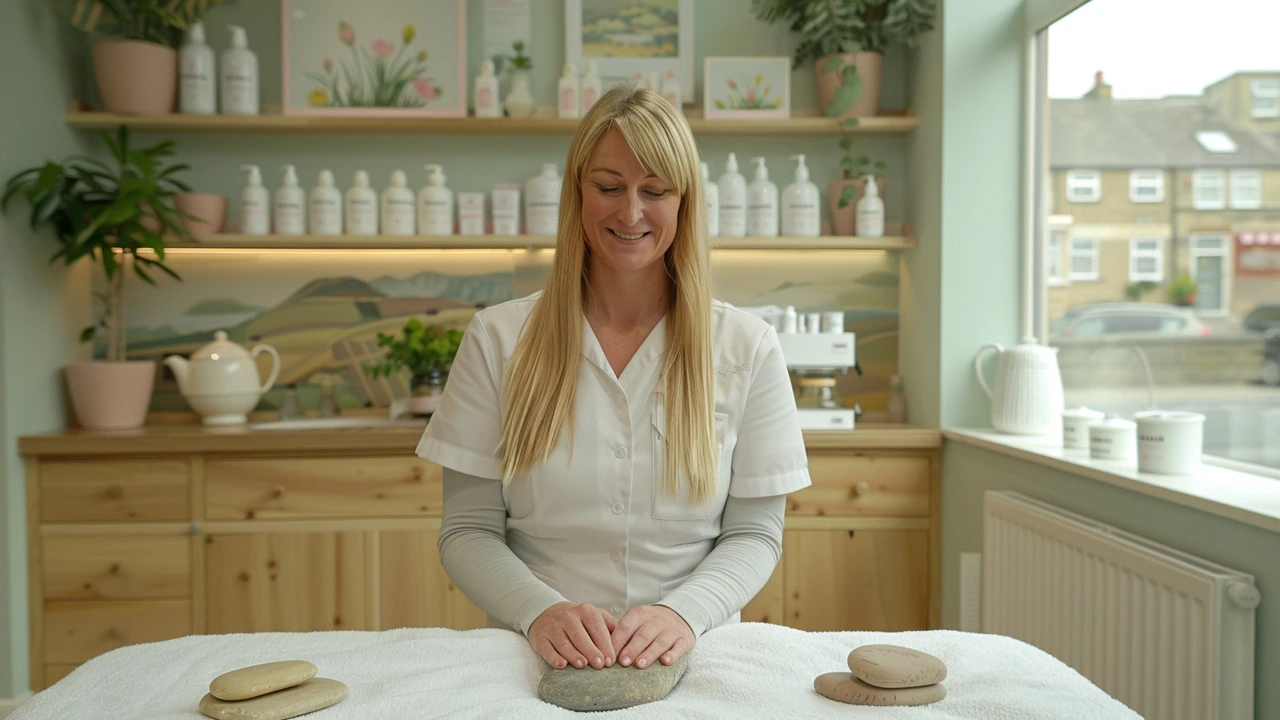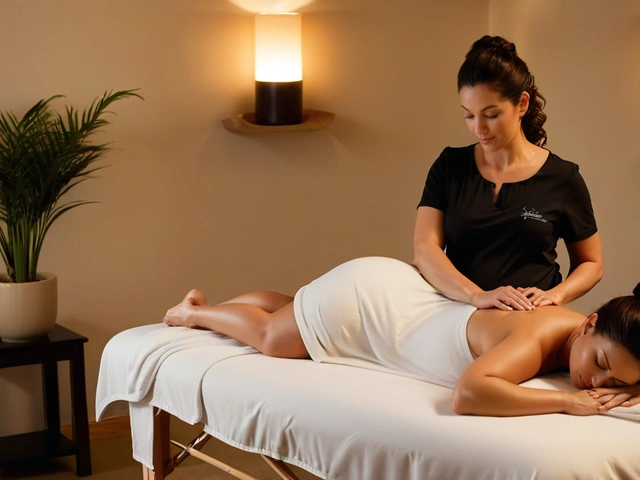
Stone massage is an ancient therapy gaining modern popularity for its remarkable benefits in pain management. This holistic approach involves using smooth, heated or cooled stones placed on specific body parts to relieve tension, improve circulation, and promote deep relaxation.
This article explores how stone massage works, its benefits, common pain conditions it can treat, and tips for getting the most from your therapy sessions. Whether you're new to this practice or looking to deepen your knowledge, you're in the right place.
- Introduction to Stone Massage
- How Stone Massage Works
- Benefits of Stone Massage
- Common Pain Conditions Treated
- Tips for Successful Treatment
- Choosing a Professional Therapist
Introduction to Stone Massage
Stone massage therapy, also known as hot stone massage, has roots that trace back to ancient civilizations including the Chinese, Native Americans, and even Egyptians. This method involves the use of smooth basalt stones that are typically heated and placed on specific points of the body to help melt away tension and stress.
The therapeutic properties of stone massage come from the combination of heat and physical pressure. Heated stones are usually placed along the spine, in the palms of your hands, or on the feet, which are major energy centers of the body. The warmth from the stones helps in relaxing muscles and improving blood flow, making it easier for the therapist to work out deeper muscle knots and tension.
One fascinating aspect of stone massage is its dual approach; hot stones relax the muscles while cold stones can be used to reduce inflammation and rejuvenate the skin. This combination can help with various conditions such as muscle strains, arthritis, and fibromyalgia. According to a study published in the Journal of Pain Research, individuals treated with stone massage reported significantly lower pain levels compared to those who received only traditional massage therapy.
Stone massage is not just about the application of heat and cold. It's also deeply rooted in holistic practices aimed at balancing mental, emotional, and physical well-being. Many therapists believe that the stones' grounding energy helps to stabilize the mind, providing a sense of calm and tranquility. This is why many consider stone massage to be more than just a physical therapy; it's a healing practice that addresses the whole person.
"The use of heated stones in massage therapy has been shown to effectively reduce muscle tension, alleviate pain, and promote a deeper sense of relaxation," explains Dr. Susan Parker, a renowned holistic health expert.Starting your journey with stone massage can be incredibly straightforward. Many spas and wellness centers now offer this service due to its growing popularity and proven benefits. The key is to find a licensed professional who is trained and experienced in this specialized form of therapy.
How Stone Massage Works
Stone massage is a therapy rooted in age-old practices that leverage the natural energies of stones to foster healing and relaxation. The process typically begins with a therapist heating smooth, basalt stones in water until they reach a comfortable temperature. These stones are known for their ability to retain heat for an extended period. On the flip side, some treatments use cool stones, usually marble, to achieve contrasting effects.
The session kicks off with the therapist placing these heated stones on key areas of the body such as the back, hands, and feet. This placement is crucial as it targets the meridian points — specific spots through which the body's energy flows. The direct application of heat helps to relax muscles deeply, alleviating tightness and reducing stress. As the muscles loosen, the therapist might use the stones to massage the body or alternate them with manual techniques, creating a dynamic, multi-sensory experience.
According to the American Massage Therapy Association, 'Stone massage not only feels amazing but has profound health benefits. The directed heat helps in reducing chronic pain and muscle spasms, making it a versatile approach.' This sentiment highlights why stone massage garners so much attention in the holistic health community.
The heat from the stones penetrates deep into the muscles, which dilates the blood vessels and promotes increased circulation. This boost in blood flow means more oxygen and nutrients are delivered to the muscles, speeding up the healing process of injured or sore muscles. Enhanced circulation also helps to flush out toxins from the body, which can be particularly useful for individuals dealing with inflammation or edema. Alternating hot and cold stones can also stimulate the lymphatic system, adding another layer of health benefits.
For those unfamiliar with the process, the idea of having stones placed on your body might seem unusual, but the results speak for themselves. The integration of this old-world technique with modern understanding of anatomy and physiology has made stone massage a preferred choice for those seeking a non-invasive way to manage pain and stress. Importantly, the type of stones used, their placement, temperature, and the techniques applied are tailored to each individual, maximizing the therapeutic benefits.
The natural elements of the stones themselves should not be overlooked. Basalt stones, for instance, are rich in iron and magnesium, which contribute to their excellent heat retention properties. Meanwhile, using marble stones for cooling therapy can help to reduce puffiness and ease tension headaches. Thus, the materials used in stone massage are selected not only for their physical attributes but also for their geological composition, providing a unique, grounded approach to pain management.
Stone massage also incorporates aromatherapy for an enriched sensory experience. Essential oils chosen for their therapeutic properties are applied alongside the stones, enhancing relaxation and adding another dimension of healing. Popular essential oils include lavender for relaxation, peppermint for invigorating the senses, and eucalyptus to aid in respiratory issues. These oils further complement the benefits of the stones, creating a holistic therapy that engages body, mind, and spirit.
Understanding how stone massage works demystifies the process and reveals why it has stood the test of time. Its ability to combine ancient wisdom with scientific principles offers a powerful tool for pain management, stress relief, and overall well-being.
Benefits of Stone Massage
Stone massage therapy is renowned for its array of benefits, particularly when it comes to pain management. At the core of these benefits is the concept of balance. When the body’s muscles and joints are well-balanced, the overall sense of well-being is enhanced. Stone massage helps align this balance, offering relief and promoting relaxation.
One significant benefit of stone massage is its ability to alleviate muscle tension. When heated stones are placed strategically on the body, the warmth penetrates deep into muscle layers, loosening knots and easing stiffness. This deep relaxation can be especially beneficial for those who experience chronic pain due to conditions like arthritis or fibromyalgia. Warm stones work by dilating blood vessels, which helps improve blood flow, delivering more oxygen to muscles and tissues.
Another notable advantage of stone massage is stress reduction. The soothing heat from the stones combined with gentle pressure provides a calming effect on the nervous system. This relaxation isn't just a physical phenomenon; it also has positive impacts on mental health. When stress levels decrease, the body’s ability to heal and recover from injury or illness improves. This makes stone massage a great option for individuals who face regular stress at work or home.
For those suffering from insomnia or other sleep-related issues, stone massage can be a remedy. The relaxation promoted during a session can help regulate sleep patterns, leading to deeper, more restful sleep. Better sleep means better overall health, as the body uses this time to repair and regenerate. Thus, incorporating stone massage into a health routine can have lasting effects on sleep quality.
Improved circulation is yet another benefit associated with stone massage. The combination of heated stones and massage techniques encourages blood flow throughout the body. Better circulation means more nutrients and oxygen reach the tissues, promoting healing and reducing inflammation. This is particularly important for athletes or individuals recovering from surgery or injury.
Finally, stone massage has been noted for its potential to relieve symptoms of certain chronic conditions. For instance, individuals with autoimmune diseases like lupus or multiple sclerosis may find relief through regular sessions. The gentle pressure and warmth can help manage pain and improve flexibility without causing additional strain or inflammation.
"Stone massage therapy provides a unique blend of relaxation and therapeutic benefits that few other treatments can match," says Dr. Jane Smith, a renowned specialist in holistic medicine. "The combination of heat, pressure, and skilled touch can offer significant relief, making it a valuable tool in pain management."
In conclusion, the benefits of stone massage extend far beyond simple relaxation. From enhancing muscle function to improving circulation and mental clarity, this therapy offers a comprehensive approach to health and well-being. When performed by a professional therapist, stone massage can be a powerful component of a holistic pain management plan.
Common Pain Conditions Treated
Stone massage therapy has become a go-to method for addressing a variety of pain-related issues. Primarily, it's known for its effectiveness in managing musculoskeletal pain. This includes conditions like back pain, neck pain, and shoulder stiffness. People working desk jobs often face tension in these areas due to prolonged sitting and poor posture.
Another common ailment stone massage treats is arthritis. The heat from the stones deeply penetrates the muscles and joints, reducing inflammation and providing relief from stiffness. Even people suffering from chronic illnesses like fibromyalgia report significant relief. Fibromyalgia can cause widespread musculoskeletal pain, and the soothing effects of the stones can make a considerable difference in quality of life.
According to the American Massage Therapy Association, regular massage can reduce pain and improve range of motion in patients with arthritis by up to 25%.People who experience frequent headaches or migraines often benefit from stone massages as well. The therapy can lower stress levels and relax tight muscles in the neck and shoulders, which are common triggers for headaches.
Additionally, those with sports injuries find that stone massage helps speed up recovery. The combination of heat and skilled massage techniques can ease muscle strain and reduce swelling. Many athletes incorporate it into their routine to maintain physical health and prevent injuries.
It's also worth noting that stone massage can significantly impact mental health conditions like anxiety and depression. While these aren't pain conditions per se, the physical relaxation achieved through massage often alleviates symptoms like tension and restlessness, which can prevent the emergence of physical pain.
In summary, stone massage therapy offers a well-rounded, holistic approach to pain management. Whether you're dealing with chronic conditions or acute injuries, the strategic use of heated or cooled stones provides a targeted, effective way to alleviate pain and promote healing.
Choosing a Professional Therapist
Finding the right professional therapist for stone massage can make a significant difference in your treatment experience and outcomes. It's essential to select someone who is not only skilled in the technique but also understands your specific needs and health conditions. Start by looking for certified massage therapists who have received proper training in stone massage therapy. Accreditation from reputable institutions like the American Massage Therapy Association (AMTA) can be a good indicator of their qualifications.
Don't hesitate to ask potential therapists about their experience, particularly with clients dealing with similar pain conditions as yours. It's crucial to feel comfortable and confident with their expertise. To gauge their proficiency, inquire about the types of stones they use, the temperature they typically work with, and their hygiene practices. Cleanliness is vital, so make sure they adhere to high standards of sanitation.
Reviews and testimonials can offer valuable insights into the therapist’s skill and patient satisfaction. Platforms like Yelp or Google Reviews often provide detailed feedback from previous clients. Additionally, word of mouth remains a reliable source; ask friends, family, or healthcare providers for recommendations. An experienced therapist should not hesitate to share references or case studies demonstrating their success with pain management through stone massage.
During an initial consultation, a competent therapist will take the time to discuss your medical history, pain points, and specific goals for the treatment. They might also provide a brief demonstration or describe their approach in detail. It's essential to clarify any doubts you have about the process and ensure that their style aligns with your comfort level. You should also feel free to request adjustments during the session to ensure your relaxation and efficacy of the treatment.
Consider the ambiance of the therapy space. A professional therapist often operates in a serene environment that promotes relaxation through calming music, aromatherapy, and comfortable settings. These elements, though seemingly minor, can greatly enhance the therapeutic experience. The setting should make you feel at ease and contribute to the overall effectiveness of the therapy.
According to Dr. Patricia Archer, a well-known holistic health practitioner, "The therapist's empathetic approach significantly influences the healing process. A competent therapist not only applies techniques skillfully but also connects with the client on an emotional level."
Lastly, pricing and session length are important factors to weigh in. While it's tempting to go for the most affordable option, quality often correlates with price. Verify what the session cost includes and whether it covers any extras like personalized follow-up advice or supplementary therapies. Reliable therapists usually maintain transparency about their pricing and have flexible packages to suit different budgets.
In summary, investing time in choosing a professional therapist guarantees a more effective and enjoyable stone massage experience. By prioritizing certification, experience, cleanliness, client feedback, and personal connection, you are more likely to reap the full benefits of this holistic approach to pain management.




